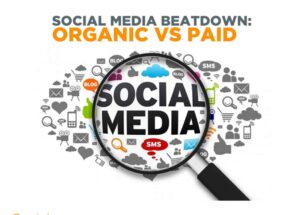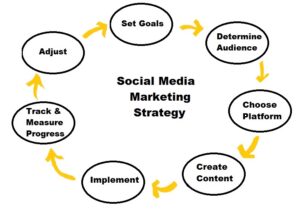WHAT IS SOCIAL MEDIA MARKETING ?
Social Media Marketing Made Simple: A Step-by-Step Guide
I don’t think I need to tell you how big social media is.
Social media is the fastest growing trend in the history of the world.
This sector has grown faster than the Internet itself.
Social media marketing is the process of creating content that you have tailored to the context of each individual social media platform in order to drive user engagement and sharing. You gaining traffic is only the result of social media marketing.
Social media campaign
Social media sites, such as Twitter and Facebook, present unique marketing opportunities. Reach new customers or build deeper bonds with your existing customers through a social media campaign.
Benefits of social media campaign
1) Increased Awareness of Your Business
Posting updates and ads on social media sites gives your business more visibility. More visibility means more views and clicks from people interested in your products and services.
2) Lead Generation
Unqualified leads from your website waste your time. Because we tailor social campaigns to your bottom-line goals, people coming to your site via social media platforms are qualified leads with real interest in making a purchase or learning more about your brand.
4 Steps to a Successful Social Media Campaign
Create a successful social media campaign by following these four steps:
1) Know your consumer.
2) Set your target.
3) Execute a plan.
4) Monitor.
1) Know your consumer
Before you can create an effective targeted campaign, you need to understand just who it is you are trying to reach. This understanding needs to extend beyond the more general demographic information (e.g. gender, age, education) in order to truly understand your targeted customers. A marketer needs to also examine more social-graphic information to understand how it is the consumer interacts with the online world. This could include information such as: which websites do they visit, how do they engage with social media, and to what extent do they interact with e-mail. In addition to this information, an effective campaign needs to center around what value the company will be bringing to the consumer. In social media, it is easy to incentivize a consumer to join a campaign (e.g. ‘like’ a Facebook group or follow a Twitter stream). However, it is much harder to get a consumer to actually engage with the campaign and remain connected. The consumer needs to see that there is value with the engagement in order for them to continue to follow the execution and becoming more invested in the campaign.
2) Set your target
What is the overarching objective that the campaign is trying to achieve? Social media does require both time and money so before considering a campaign, there needs to be a purpose in mind. An example of a desired result or objective would be to “increase sales of a new product”. From this objective, goals need to be unearthed. Goals in this case need to be SMART (Specific, Measurable, Achievable, Realistic, Time-bound). An example of a goal could be “To increase sales of the new product by 20% by next month”. Setting this goal gives you a clear idea of what to shoot for.
3) Execute a plan
Too often, an executive will provide direction that the company should be on a social media site (especially Facebook or Twitter). However, this may not make sense to achieve the business’s objectives as stated in the previous step. A marketer needs to decide what the best tactics are to achieve the desired goal. Although a very popular website, Facebook may not be the best mechanism for ever goal or every audience. Consider the previous steps to determine what may be the most effective tactics. It is also important to consider how the tactics can work together to create a more compounding impact. Also consider the future of the campaign. Does the campaign have legs? Can it move to a new phase once this execution is completed, or is this the end?
4) Measure
How do you know how successful you are if you don’t measure your results? If you don’t know how successful you are, how can you receive a budget for a future campaign? It is critical that the goals are tied to specific measurements. In the age of online, measurements have become much easier. There is now so much data that is available in real-time that a marketer is always kept informed. However, it is important to consider just which mechanisms are being monitored before the campaign begins. Throughout the campaign metrics need to be monitored to see if the campaign is having the desired impact. If not, the tactics may need to be rebalanced on the fly to ensure that the goals are being achieved before the campaign dollars run out.There is a reason that this diagram is created as a cycle. This is a continuous feedback loop, which relies on learnings from the past to inform the future. Social media is a new field for marketers but it still relies on the same overall knowledge.
ORGANIC SOCIAL MEDIA
The main lesson from this article is simply, “Social media is a great tool, but spending the time to create a strategy and to monitor the campaign will increase the likelihood of success”
Organic social media is anything that happens on social media without paid promotion. When you post as your page but don’t put any money behind this post to “boost” it, you are creating an organic post.
Organic social media is the use of the free services and tools that each social media platform provides to its users. … The purpose of organic social media is to build a community of loyal followers and customers through posting relevant content, and interacting with those who interact with your brand.
TOOLS OF SOCIAL MEDIA MARKETING
6 SOCIAL MEDIA MARKETING TOOLS THE EXPERT USE.
1) Buffer
With its clean interface and simple analytics features, Buffer just barely edges out Hootsuite as my favorite social media scheduling tool. You can share content across multiple accounts and networks, all from one central dashboard.
A Chrome extension makes it even easier to share on Facebook, Twitter, Pinterest, Google+ and even LinkedIn simultaneously. Buffer has some epic social media guides and case studies on its blog, which is a great place to start if you’re new to social media marketing.
2) Social Clout
It’s all well and good to share content and get likes. In fact, it can be quite addicting. But to really understand which posts get the most engagement, we need to look past vanity metrics and focus on the metrics that matter.
Enter Social Clout, a social media analytics tool designed specifically to track engagement and calculate social media ROI. Social Clout shows you which demographics have the best engagement and which platforms convert the best, and at what times.
3) Feedly
Put your content ideation on autopilot, with Feedly. To set it up, just add the RSS feeds of your favorite blogs and writers and Feedly will create a daily “magazine” with all its content, organized by topic.
Moreover, Feedly is a great way to know what niche influencers are talking about, to join the conversation and to stay up to date with the latest industry trends. Staying up to date with the latest current events helps guide your own content strategy and social media posting schedule.
What’s great about the app is that it integrates with scheduling tools like Buffer and Hootsuite, so you can share and schedule posts from directly within the dashboard. In my own work, Feedly saves me hours of time and energy combing through social media posts to find good content.
What’s great about the app is that it integrates with scheduling tools like Buffer and Hootsuite, so you can share and schedule posts from directly within the dashboard. In my own work, Feedly saves me hours of time and energy combing through social media posts to find good content.
4) Canva
Here’s a thing most people don’t know about me: I’m terrible at graphic design. (Blog design is another story.)
This is especially true when it comes to choosing and editing photos for my blogs. Luckily, there’s a tool that’s built specifically for non-designers: Canva.
Canva is my favorite tool for creating stunning images for social media posts. Creating images is so easy even a bean-counting marketer could do it. Using Canva’s multiple templates, fonts and colors, all you need to do is drag image elements around and drop them into place.
Canva is free to use, but don’t let that fool you. Despite its affordability, major sites like Buzzfeed use Canva to create images for their posts (which, last I checked, drive nearly half a billion visits each month).
5) Socedo
Social media campaigns have countless moving pieces, all of which need to work together if the campaigns are to be successful. Whether you’re an entrepreneur or an established social media manager, there’s never enough time in the day to manage it all while still you’re looking for customers.
Socedo is a B2B demand generation tool that does most of the grunt work, so you don’t have to. It works by automating lead generation, and finding and acquiring targeted leads through different social media channels. That way, you can focus on increasing ROI (sales and revenue) without getting bogged down in minutiae and repetitive tasks. Using a combination of keywords and demographic criteria, Socedo finds and engages prospects across major social networks. Whereas most demand-gen platforms focus on email, Socedo is one of the few that handles outbound prospecting via social.
6) Edgar
Ever notice how influencers like Tim Ferriss, Gary Vaynerchuk and Richard Branson repeatedly share their old content?
While that practice may appear redundant or irksome, the fact is that old posts have high engagement when shared. It’s just plain smart.
First, social media accounts gain and lose followers with time. Re-sharing content is an excellent way to showcase your top stuff to new followers. Second, even the most loyal fans won’t be online all the time. Regular sharing is a way to engage with audiences at different times throughout the day
That said, it’s not always easy to know the best social media schedule for new and old content. Edgar knows, and shares your content at the times when it’s most likely to engage your audience. The tool categorizes all ofyour content by topic and target demographic, determining which posts get the highest engagement with which followers.
Edgar doesn’t stop there. After posting an update, the tool recycles the post back to the bottom of your queue, so it will post again later once the rest of your content has been shared. The result is an endless supply of social media posts that shares and reshares itself continuously, without you having to lift a finger.
What are the advantages if one use social media tools?
It saves a lot of time
By one login you can manage easily 3-6 social media channels
All social media channels under one platform, hence it is easy to observe user engagement
Gets better with social media analytics.
How to create a social media strategy
Step 1. Choose social media marketing goals that align to business objectives
Set S.M.A.R.T. goals
Each of your goals should be:
✓Specific
✓Measurable
✓Attainable
✓Relevant
✓Time-bound
Step 2. Learn everything you can about your audience
Create audience personas
When it comes to your target customer, you should know things like:
✓Age
✓Location
✓average income
✓Typical job title or industry
✓Interests
✓etc.
Step 3. Know your competition
Odds are your competitors are already using social media, and that means you can learn from what they’re doing.
Conduct a competitive analysis
A competitive analysis allows you to understand who the competition is and what they’re doing well (and not so well). You’ll get a good sense of what’s expected in your industry, which will help you set social media targets of your own.
It will also help you spot opportunities.
Maybe one of your competitors is dominant on Facebook, for example, but has put little effort into Twitter or Instagram. You might want to focus on the networks where your audience is underserved, rather than trying to win fans away from a dominant player.
Step 4. Do a social media audit
If you’re already using social media, take stock of your efforts so far. Ask yourself the following questions:
What’s working, and what’s not?
Who is engaging with your?
Which networks does your target audience use?
How does your social media presence compare to the competition?
Step 5. Set up accounts and improve profiles
Decide which networks to use
As you decide which social networks to use, you will also need to define your strategy for each.
Set up your profiles
Make sure you fill out all profile fields
Include keywords people would use to search for your business
Use consistent branding (logos, images, etc.) across networks so your profiles are easily recognizable
Step 6. Evaluate and adjust your strategy
Your social media strategy is a hugely important document for your business, and you can’t assume you’ll get it exactly right on the first try. As you start to implement your plan and track your results, you may find that some strategies don’t work as well as you’d anticipated, while others are working even better than expected.
Look at performance metrics
In addition to the analytics within each social network (see Step 2), you can use UTM parameters to track social visitors as they move through your website, so you can see exactly which social posts drive the most traffic to your website.
Re-evaluate, test, and do it all again
Once this data starts coming in, use it to re-evaluate your strategy regularly. You can also use this information to test different posts, campaigns, and strategies against one another. Constant testing allows you to understand what works and what doesn’t, so you can refine your strategy in real time.
Surveys can also be a great way to find out how well your strategy is working. Ask your followers, email list, and website visitors whether you’re meeting their needs and expectations, and what they’d like to see more of. Then make sure to deliver on what they tell you.





3 Comments
Ayushi gahlot · June 15, 2020 at 5:03 pm
Nice?
Ayushi rajoriya · June 15, 2020 at 6:28 pm
Outstanding
Adarsh yadav · June 15, 2020 at 7:30 pm
Excellent , good , Nice contain